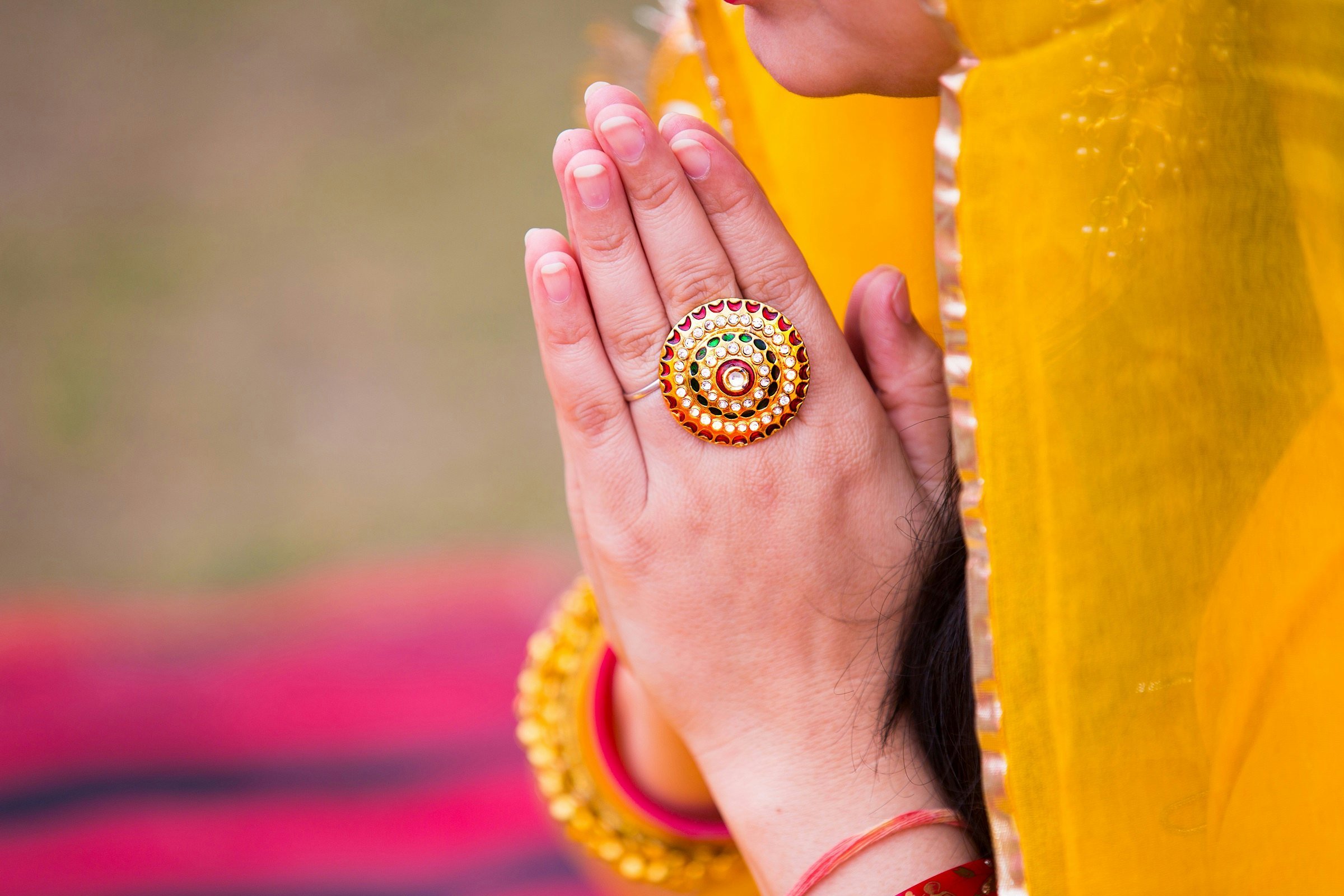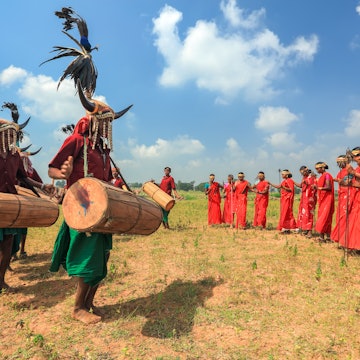
Greeting customs from around the world (and how to do them properly)

Jan 11, 2021 • 7 min read

While handshakes are popular on an international level, there are plenty of other ways to say hello © May_Chanikran/Shutterstock
The coronavirus currently has us bumping elbows and waving hello from afar, but greetings around the world are often more involved than that, even in non-pandemic times. From bowing in Asia to rubbing noses in the Middle East to cheek kisses across the globe, here are a few customary greetings from around the world.

Touching noses
Whether it’s called khashm-makh in the Gulf states or kunik by the Inuit people of Canada and Greenland, going nose-to-nose is a tried-and-true way of saying hello. In countries like Oman and the United Arab Emirates, Bedouin tradition calls for rubbing noses and shaking hands at the same time, and while the kunik may look like a similar ritual, in practice it’s something else entirely, and sniffing is the name of the game.
"Inuit do not touch noses end to end or rub them back and forth against each other,” writer, artist, and spoken-word poet Taqralik Partridge once told Esquire. “We place our nose over the place we intend to kunik, press our nostrils against the skin, and breathe in, causing the loved one's skin or hair or any other part to be suctioned against our nose and upper lip."

Hongi, the traditional greeting of New Zealand’s Māori people, is often mistaken for a simple nose rub, but there’s more to it than that. A ritual with spiritual elements rooted in mythology, the hongi sees two people clasp hands, press noses and foreheads together, and inhale each other’s breath, much like the god Tāne-nui-a-Rangi is said to have breathed life into the first woman. This sharing of breath is “a symbolic show of unity between two people,” Dr. Angus Hikairo Macfarlane, professor of Māori research at the University of Canterbury, explained to Stuff.
It’s not exactly a pandemic-friendly practice, and indeed, hongi was discouraged by New Zealand’s prime minister and officially restricted by at least one local iwi, or tribe, as cases surged last spring. But in December, when one politician voiced concerns about the custom’s eventual return in light of the coronavirus, others sprang to its defense. "There will always be a place in Māori society for the hongi," the minister for Māori-Crown relations, Kelvin Davis, said.
Sticking out your tongue
It may seem rude or flippant to the uninitiated, but in Tibet, sticking out your tongue has long been a way of saying hello. The practice originated with the 9th-century death of a malevolent king who had a black tongue: As the story goes, the country’s Buddhist adherents believed he would be reincarnated, so they began to stick their tongues out to prove they weren’t the tyrant reborn. Today, the greeting is more subtle than it was in years past, and it’s also become an indication of respect and agreement
Bowing
Bowing is traditional in many parts of Asia, though the specifics change from country to country. In Japan, the practice known as ojigi varies depending on the situation, and how deeply you genuflect and whether you’re standing or kneeling is determined by a number of factors: whether it’s a business relationship or a social one, the people you’re interacting with and the level of respect they engender, whether you’re expressing gratitude or an apology, saying hello or goodbye, paying a visit to a temple or a shrine, or just picking up a few things from the local shop.
For a standing bow, keep your legs together and your back straight, bend at the waist, keep your hands at your sides (if you’re a woman, you can also hold them together in front of your thighs), and don’t make eye contact until the ritual is complete. For casual interactions, a 15-degree inclination – or even a basic head nod – should be appropriate, especially for foreigners, though more formal occasions require a deeper angle.

Similarly, the Hindu namaste is used to indicate respect and gratitude in countries like India, Nepal, and Bangladesh. The word translates directly from the Sanskrit to “I bow to you,” and when it’s executed in the traditional fashion, with hands pressed together in front of your heart as if in prayer, a bow is indeed involved. In its modern incarnation, however, the bow is often omitted and the word “namaste” is uttered on its own – except when addressing people held in high esteem, like elders or VIPs, in which case the bow adds an extra level of deference.
Another variation on the theme is the Thai wâi, a show of respect in which the hands are placed together prayer-style at chest level, with palms and fingers touching, elbows tucked in, and the head inclined downward. It’s a gesture used for multiple purposes – to say hello or goodbye, apologize or thank someone – and also differs from case to case, based mainly on the age and status of the person being addressed. In settings involving friends, acquaintances, and people of the same social standing, a brief nod in which your thumbs touch your chin and your nose touches the tips of your index fingers will do the trick, though for people your own age, the nod alone should be sufficient. With elders or superiors, the nod is deeper and the hands are raised so your nose touches your thumbs and your forefingers rest between your eyebrows, and with monks, the hands are even higher – your thumbs should be between your eyebrows and your index fingers should touch the forehead – and there’s a slight bow involved as well. Those with a lower social status will wâi first, and if they’re a child or someone you’re paying for a service, like a waiter or taxi driver, you’re under no obligation to return the gesture.

Cheek kissing
Cheek kisses are common in so many countries across the globe that it’s tough to keep track of them all. In France, where it’s known as la bise, the number of kisses ranges from one to four from city to region to village, but two is by far the most common. Among others, Spain, Brazil, Germany, Italy, Romania, Turkey, and Tunisia go for two as well, while countries like Lebanon, Belgium, Egypt, and the Netherlands opt for three and South American spots like Argentina, Chile, and Peru stick with a solitary smack. But not literally – proper form is to touch cheeks, not lips, while making a soft kissing sound.
Then there’s the question of who smooches whom. Air kisses between two men are less common than between two women, and in most conservative cultures, mixed-gender kisses are verboten, though they’re de rigueur in other parts of the world. Which cheek touches which can also be a matter of confusion. Parisiennes, for example, prefer to start the process with their right cheeks touching, but in Italy, where the practice is said to have originated thanks to the ancient Romans, the opposite tends to be true. Your best bet? Follow a local’s lead.
Hand gestures
A firm handshake is prized in the US and abroad, but other cultures take mano a mano to the next level. In the Philippines, the gesture called mano po is a respectful greeting similar to kissing an elder’s hand, but rather than bringing the back of their hand to your lips, it’s raised to touch your forehead instead. In Botswana, a three-part handshake follows a verbal salutation: First, prop your right elbow up with your left hand as a show of deference and extend your right hand for a shake, then change it up so your thumbs interlock; finally, take it back to the original position and shake one more time. You could also shake hands in Zambia, but going no-contact is an option as well. Just cup your hands, clap, and say hello (muli bwanji in Nyanja), bending your legs or squatting low if you need to pay more respect.
You may also like:
The Lonely Planet 2021 Challenge: Learn to say hello in 25 different languages
The ultimate guide to tipping around the world
11 ways to upgrade your travel game
Simple yet effective: the only travel tips you'll ever need












